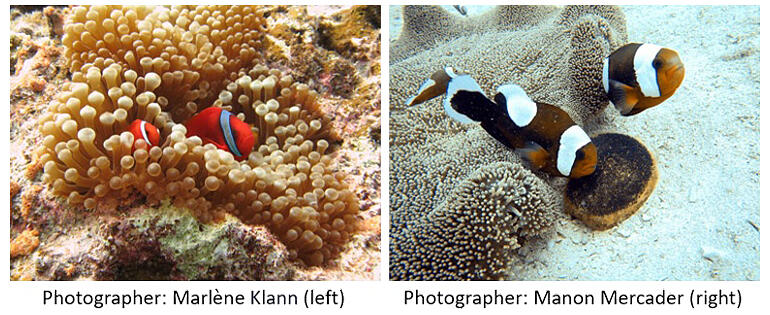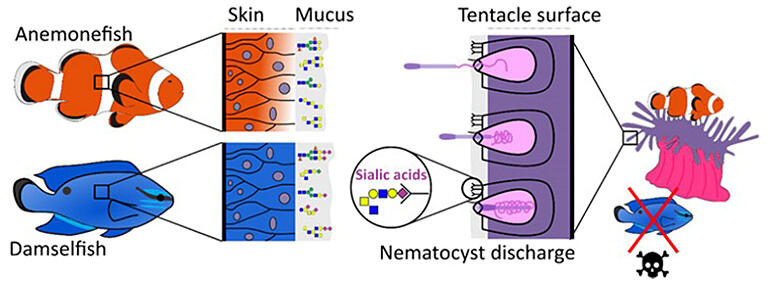A research group from the Okinawa Institute of Science and Technology (OIST) has discovered that clownfish, which co-exist with sea anemones despite the toxic stings on the latter's tentacles, do not get stung by sea anemones because the sialic acid sugar molecules on their body surface decrease as they grow. They also found that sea anemones themselves lack sialic acid, which prevents their own toxic stings from firing and stinging themselves. The researchers stated that this finding "provides a clue to understanding the mechanism of symbiosis."

Provided by OIST
Sea anemones have capsules called nematocysts on their tentacles that fire toxic stings when stimulated. Not only humans but many fish can be stung. Depending on the type of sea anemone, the sting can be severe, requiring careful handling. However, it was previously unknown why clownfish, familiar from animated movies, can avoid being stung and live in sea anemones as if in a cradle.
The research group, led by Professor Vincent Laudet who studies ecology and evolutionary biology from OIST's Marine Eco-Evo-Devo Unit, focused on a previously known phenomenon—that "sea anemones fire their toxic stings when they come into contact with specific sugars," and investigated whether the absence of these sugars would prevent nematocyst stimulation.
By combining methods to investigate the presence of sugar molecules and examining the activity of genes that suppress sugar metabolism, they studied the amount of sialic acid, a type of surface sugar, from clownfish larvae to adults. Sialic acid is a substance found in various organisms and involved in biological reactions. They found that while larvae have the same amount of sialic acid as other fish, the sialic acid decreases around the time their white and orange stripes develop. Additionally, they discovered that sea anemones' surface lacks sialic acid, which explains why their toxic stings do not fire when their own tentacles touch each other.

Provided by OIST
Clownfish larvae, after birth, rise to the sea surface and are carried by ocean currents to the open sea to grow. However, because larvae are extremely small, discovering them in the vast ocean is difficult, and their detailed ecology remains unclear. What is known so far is that they can move extremely long distances of 35 kilometers in two weeks.
Laudet said the symbiotic relationship between clownfish and sea anemones "goes beyond mere defense against predators." Sea anemones also live symbiotically with zooxanthellae, a photosynthetic plankton that lives with corals. Previous research has shown that the presence of clownfish helps repel predators that might attack sea anemones and assists in the establishment of zooxanthellae within the sea anemones. Laudet added, "Zooxanthellae provide more than 80 percent of the energy needed by sea anemones through photosynthesis. Clownfish may also play a role in maintaining and strengthening this symbiotic relationship."
The researchers also investigated the sialic acid of the threespot dascyllus (a type of damselfish), which only symbioses with sea anemones during its larval stage, and found that the amount is low during the juvenile stage. It's worth noting that clownfish and damselfish are not closely related species. In this way, the amount of sialic acid determines whether an organism can live symbiotically with sea anemones.
Laudet reflected, "The process by which clownfish chemically deceive sea anemones from the inside, making them believe the fish are part of their own group by lacking sialic acid, is like a 'Trojan horse'." While clownfish live symbiotically after infiltration, he believes that "symbiosis is one strategy for adapting to the harsh marine environment. Studying symbiosis is key to understanding the fundamentals of complex life."
The researchers want to investigate how clownfish reduce sialic acid as they grow. They also plan to conduct artificial intervention experiments, doing the opposite of what occurs in nature—artificially coating adult clownfish with sialic acid and removing sialic acid from fish that do not typically symbiose with sea anemones—to directly prove the causal relationship between sialic acid and toxic sting firing.
The research was funded by the Joint Usage/Research Center Glyco Science Cooperative Network (J-GlycoNet) and conducted jointly by the French National Centre for Scientific Research and OIST. The findings were published in the electronic version of the German scientific journal BMC Biology on February 15 and announced by OIST on the same day.
Original article was provided by the Science Portal and has been translated by Science Japan.




